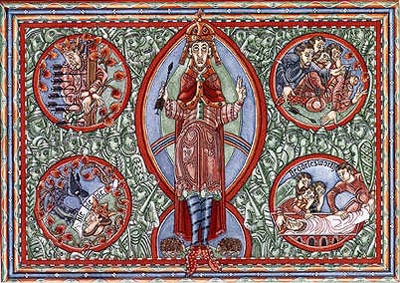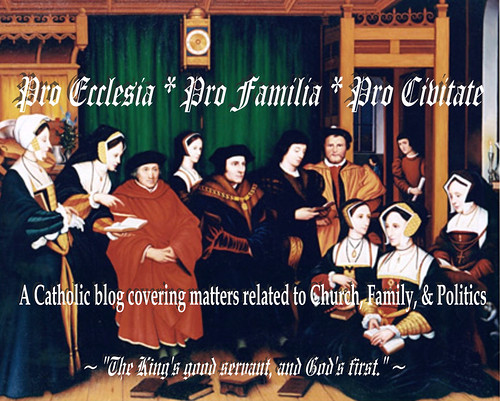St. Edmund of East Anglia, King and Martyr
 On our trip to England a couple months ago, during which my family spent a week in East Anglia - where Sarah's Granny was born, we learned quite a bit about St. Edmund. He has become one of my favorite saints - so much so that if little Mary Virginia, who is due in March, had been a boy, his middle name would have been "Edmund". Unfortunately, a planned trip to the saint's final resting place in the town of Bury St. Edmunds and St. Edmundsbury Cathedral did not happen due to the demands of travelling with 2 toddlers. Oh well, hopefully, we can get there on another visit to the U.K.
On our trip to England a couple months ago, during which my family spent a week in East Anglia - where Sarah's Granny was born, we learned quite a bit about St. Edmund. He has become one of my favorite saints - so much so that if little Mary Virginia, who is due in March, had been a boy, his middle name would have been "Edmund". Unfortunately, a planned trip to the saint's final resting place in the town of Bury St. Edmunds and St. Edmundsbury Cathedral did not happen due to the demands of travelling with 2 toddlers. Oh well, hopefully, we can get there on another visit to the U.K.The following details about the life of St. Edmund come from the Medieval Saints Yahoo Group (go check it out):
St. Edmund of East Anglia
Also known as Edmund the Martyr
Martyred by being beaten, whipped, shot with arrows and beheaded at Hoxne, Suffolk, England 20 November 870; buried at Hoxne; relics moved to Beodricsworth (modern Saint Edmundsbury) in the 10th century
Commemorated November 20
Patronage: kings, plague epidemics, torture victims, wolves
In art, he is shown with an arrow; king tied to a tree and shot with arrows; wolf; bearded king with a sword and arrow; man with his severed head between the paws of a wolf; sword
"The tree at which tradition declared Eadmund to have been slain stood in the park at Hoxne until 1849, when it fell. In the course of its breaking up an arrow-head was found embedded in the trunk. A clergyman who had a church which was dedicated to St. Eadmund begged a piece of the tree, and it now forms part of his communion-table. Another portion is in the possession of Lady Bateman of Oakley Hall" - Dictionary of National Biography. Ed. Leslie Stephen and Sidney Lee, 1908-1909
Edmund the Martyr, King (RM)
http://www.saintpatrickdc.org/ss/1120.htm#edmu
Born 841; died at Hoxne, Suffolk, England, in 869 or 870. Feast day formerly November 2.On Christmas Day 855, 14-year-old Edmund was acclaimed king of Norfolk by the ruling men and clergy of that county. The following year the leaders of Suffolk also made him their king.
For 15 years Edmund ruled over the East Angles with what all acknowledged as Christian dignity and justice. He himself seems to have modelled his piety on that of King David in the Old Testament, becoming especially proficient in reciting the Psalms in public worship.
From the year 866 his kingdom was increasingly threatened by Danish invasions. For four years the East Angles managed to keep a shaky, often broken peace with them. Then the invaders burned Thetford. King Edmund's army attacked the Danes but could not defeat the marauders. Edmund was taken prisoner and became the target for Danish bowmen.
In a later account in the The Anglo-Saxon Chronicle, reputedly derived second-hand from an eyewitness, Abbo compared Saint Edmund to Saint Sebastien, and so he also became a saint invoked against the plague. The story goes that Edmund was captured at Hoxne. He refused to share his Christian kingdom with the heathen invaders, whereupon he was tied to a tree and shot with arrows, till his body was 'like a thistle covered with prickles'; then his head was struck off. He died with the name of Jesus on his lips.
The record continues that the Danes "killed the king and overcame all the land . . . they destroyed all the churches that they came to, and at the same time reaching Peterborough, killed the abbot and monks and burned and broke everything they found there."
Saint Edmund thus remains the only English sovereign until the time of King Charles I to die for religious beliefs as well as the defense of his throne. Edmund was quickly revered as a martyr and his cultus spread widely during the middle ages (Attwater, Benedictines, Bentley, Hervey, Roeder).King Saint Edmund is generally depicted as a bearded king holding his emblem--an arrow. Sometimes he is shown suspended from a tree and shot, or his head between the paws of a wolf. He is sometimes confused with Saint Sebastien, who is never portrayed as a king (Roeder).
He is venerated at Bury Saint Edmunds (Saint Edmund's borough), where his body is enshrined and a great abbey arose in 1020. Richard II invoked him as patron as to those threatened by the plague (Roeder).
---------------------------
More on St. Edmund of East Anglia at:
http://www.stedmundsbury.gov.uk/sebc/visit/stedmund.cfm
http://www.orthodox.net/western-saints/edmund-martyr-king-of-east-anglia.html
http://www.newadvent.org/cathen/05295a.htm
http://www.ewtn.com/library/MARY/STEDMUND.htm
http://www.traditioninaction.org/SOD/j048sdEdmund11-21.htm
http://www.fordham.edu/halsall/source/870abbo-edmund.html
http://www.ualberta.ca/~sreimer/edmund/intro/a-s-chrn.htm



1 Comments:
Great post, Jay. I know who we'll be reading about tonight at the Leonardi home.
When I was in London a month ago, I nearly spent half my paycheck at the St. Paul's bookstore next to Westminster Cathedral. One of the books that I had in my hand but elected not to purchase was Bogle's.
A book that did make the cut was Fr. Mark Elvins' "Catholic Trivia: Our Forgotten Heritage." It has proved to be a great find. Check out my review on Amazon.
Post a Comment
<< Home